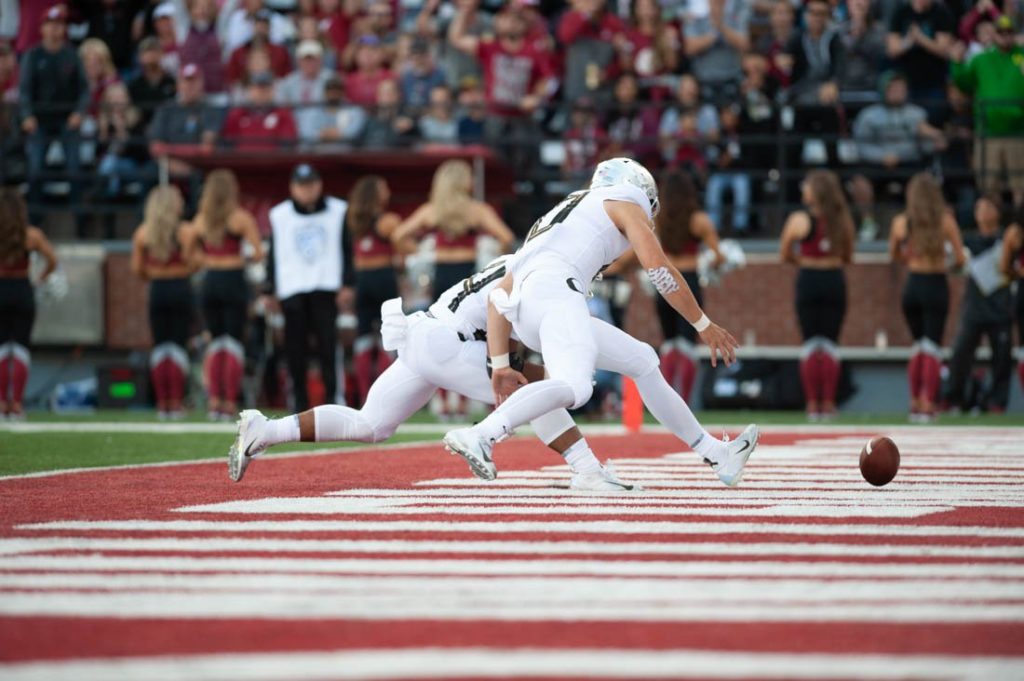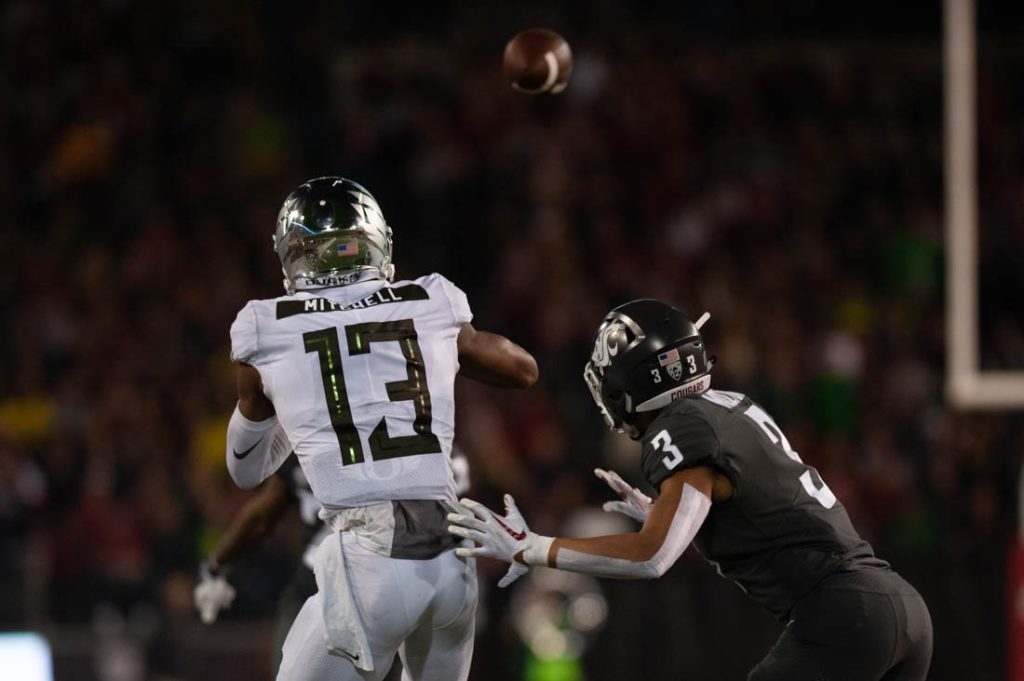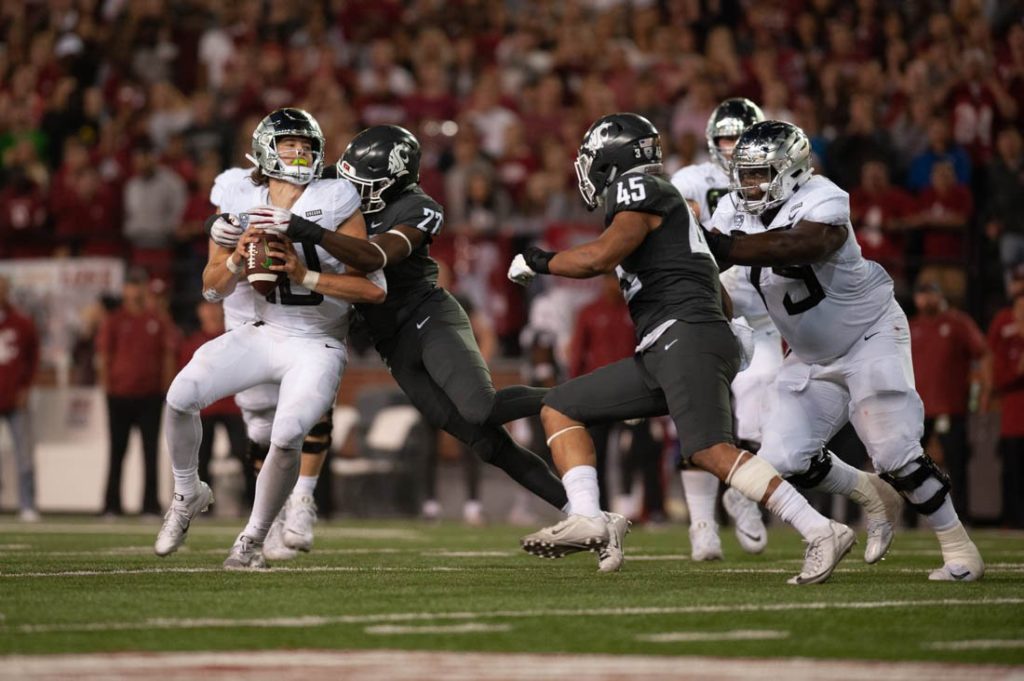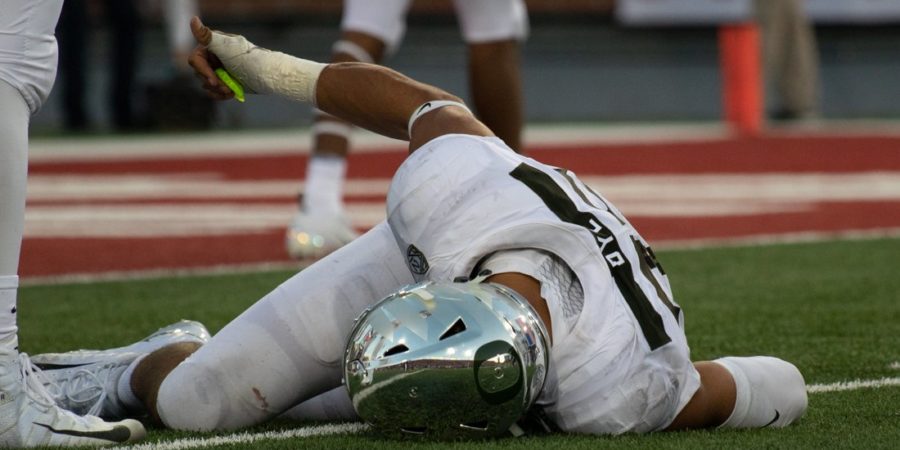After knocking off preseason Pac-12 favorite Washington a week ago, a major question entering the week asked how would Oregon handle the role reversal would have them playing the role of “hunted” opposed “hunter” entering Saturday’s game in Pullman versus no. 25 Washington State.
The answer now, it seems, is “not well,” as the 12th-ranked Ducks fell to the Cougars, 34-20, in front of a rabid crowd inside Martin Stadium. A win over the Cougs would have put Oregon in prime position to take the Pac-12 North division title. Instead, the Ducks sink back to fourth place in the division and are seeking some help in order to regain at least a portion of the inside track to the Pac-12 Championship Game.
Below, WFOD takes a look back and attempts to digest what was undoubtedly Oregon’s worst performance of the year.

1. Uneven performance between first and second half costs Oregon
In what is developing as a recurring theme, the Ducks once again struggled to piece together a complete performance for four quarters in all phases. Going all the back to Oregon’s lackluster showing in the second half versus San Jose State over a month ago, the Ducks have been a curiously uneven team between the first and second half ever since. Prior to Washington State, the Ducks have made a particular habit of getting off to strong starts underscored by well-composed offensive drives in the first half, only to fade to varying degrees in the second half of games.
On Saturday, this chronic unevenness reared its ugly head once again, though the halves in which the Ducks were inconsistent were essentially reversed. For the first time all season, Oregon looked like a team that was wholly unprepared to start the game. After Deommodore Lenoir intercepted Washington State’s Gardner Minshew deep in Duck territory on the Cougars first drive of the game, the Oregon offense took over looking to establish early momentum. Instead, the Ducks’ first series was marred by botched snaps (including one that could have resulted in a safety if not for an Oregon pre-snap penalty) and penalties, which more or less set a frustrating and inconsistent tone for the rest of the first half. In particular, the Ducks were dominated by the Cougars on first down in the opening quarter – a troubling fact considering Mario Cristobal’s emphasis on needing to win the first down battle in the build up to this game.
How badly were the Ducks outplayed in this aspect of the game? At the end of the first quarter, Washington State was averaging seven yards per first down attempt, while Oregon averaged -3.5 yards. In fact, Oregon’s only first down of the quarter came courtesy of a pass interference penalty on the Cougars, as the Ducks only managed eight yards of total offense in the first frame. In fairness to the offense, the Oregon defense was arguably just as bad, as Minshew and the Cougar offense jumped out to a commanding 27-0 lead in a first half that essentially saw Washington State do whatever they wanted on offense. If you’re looking for a play that epitomized the first half for both teams, look no further than James Williams’ 24-yard touchdown run in which he shed five Oregon tacklers before barreling his way to the end zone.
James Williams with the first touchdown of the night! #GoCougs #DuckHunt pic.twitter.com/u4Q4jfinbK
— WSU Cougar Football (@WSUCougFB) October 21, 2018
Credit the Ducks for mounting an inspired comeback in the second half which saw them cut Wazzu’s lead to 27-20 midway through the fourth quarter, but the inconsistency throughout the game proved to be far too much to overcome. In a season that has engendered a tremendous amount of positivity in terms of the long-term trajectory of the Oregon football program, the lack of four-quarter consistency we’ve seen from this team is perhaps its most troubling trait.
2. Hangover affect from last week’s game?
It’s hard to believe there wasn’t. As thrilling as last Saturday’s win over Washington was, you just knew that it was going to be difficult for Oregon to restore themselves emotionally and elevate their intensity to the level of Washington State, especially considering the hype and fervor that surrounded the game spearheaded by College GameDay’s first ever appearance in Pullman. Lenoir insinuated as much in the aftermath of Saturday’s loss to the Cougars, but the proof was in the pudding in the first half. The ugly first half statistics say it all, but perhaps it’s not really a surprise considering the number of new lessons this team has learned through the first half of the season.
Against Stanford, the Ducks discovered they have the capacity to rise to the challenge of playing in a critically important game and play well enough to win, even though they were handed the “L.” At Cal, Oregon proved to itself that it can shake off a tough loss and pick up a win on the road against a conference foe. Against Washington, the Ducks finally got over the hump, defeating their first top 10 ranked team in four years and announcing themselves as a threat once again in the Pac-12. Now, after being handed a sobering loss on the road at Washington State, the hope is that this team has learned the importance of refocusing after a rousing victory and that guarding against elements of hubris are just as important as having intense self-belief. It’s a fine line to walk and one that has come with its fair share of trials and tribulations as this team continues to mature and coalesce.

3. Ducks’ lack of offensive playmakers becoming glaring issue
It’s been a truth Duck fans have downplayed for awhile now, though it was a sentiment that could more or less be swept under the rug based on the success the Ducks had been enjoying through six games. Following Saturday’s loss to Washington State, however, the topic is now officially unavoidable: Oregon simply lacks playmakers on offense. The exploits of Justin Herbert and Dillon Mitchell have been well documented – both players are all-conference caliber performers who have proven they can carry a substantial offensive load. Additionally, running back CJ Verdell has emerged as a reliable threat on the ground having rushed for over 100 yards in each of the three previous games. Beyond that though, the Ducks are devoid of players they can turn to if skilled guys like Mitchell and Verdell are neutralized.
True freshman running back Travis Dye has had his moments throughout the season, but was held to negative-four yards rushing on three attempts against the Cougars. In the passing game, Jacob Breeland, Jaylon Redd, and Brenden Schooler each hauled in four receptions, but none of the three demonstrated a consistent ability to loosen up the Cougar defense by providing explosion plays. Furthermore, sophomore wide receiver Johnny Johnson has been a non-factor that continues to be plagued by drops, while Wake Forest grad transfer Tabari Hines has hardly seen the field since the Portland State game. Despite all this, the Ducks have been able to put together a formula for success on offense that has earned a passing grade, but in terms of overall talent and proven ability, Oregon’s offensive playmakers are slightly above average at best. Given the remainder of their schedule, it may not continue to be an obvious issue, but it’s one that must be addressed if the Ducks are to eventually take that next step as an offense.

4. Oregon was whipped upfront
For the first time since the start of conference play, the Ducks were thoroughly whipped upfront by an opponent. Specifically, the Oregon offensive line was outplayed by an undersized Washington State front seven that played with a level of intensity that the Ducks simply couldn’t match. In game that Oregon needed to win by punishing the Cougars on the ground by virtue of their size, strength, and physicality advantage in the trenches, they were held to less than 100 yards rushing (58, to be exact) for the first time since the Las Vegas Bowl debacle versus Boise State last season. In fact, the Ducks were straight up outgained on the ground by the conference’s worst rushing offense (77-58), a figure that could have been made worse if not for Verdell’s 20-yard gain (his longest of the game) in the third quarter. On top of that, Herbert was sacked three times, as the Cougars tallied a total of seven tackles for loss.
5. Uncommon third down woes
Entering Saturday’s game, the Ducks were one of the nation’s most efficient teams on third down. Offensively, the Ducks ranked in the top 10 in third down conversion percentage, converting on third down just over 51 percent of the time (51.7). To Washington State’s credit, they’ve been a team who has been effective both limiting opponents on third down and converting third down with their offense on the field, but Oregon’s third down struggles were nonetheless unexpected and impactful within the scope of this game. Against the Cougs, the Oregon offense was only 5-of-16 on third down, while the Duck defense surrendered nine first downs to Washington State on 14 third down attempts. The Ducks performed much better in this category in the second half, but the third down struggles in the first half had as much to do with Oregon’s lackluster performance as anything else.
News and notes:
- Justin Herbert extended his streak to 22 consecutive games with a touchdown pass, which is the longest active streak in the nation
- Deommodore Lenoir is the third different Duck with two interceptions in a game this season, joining Ugo Amadi and Jevon Holland
- Kaulana Apelu’s career-high 14 tackles are the most by an Oregon player since Joe Walker had 15 vs. USC (11/21/2015)

